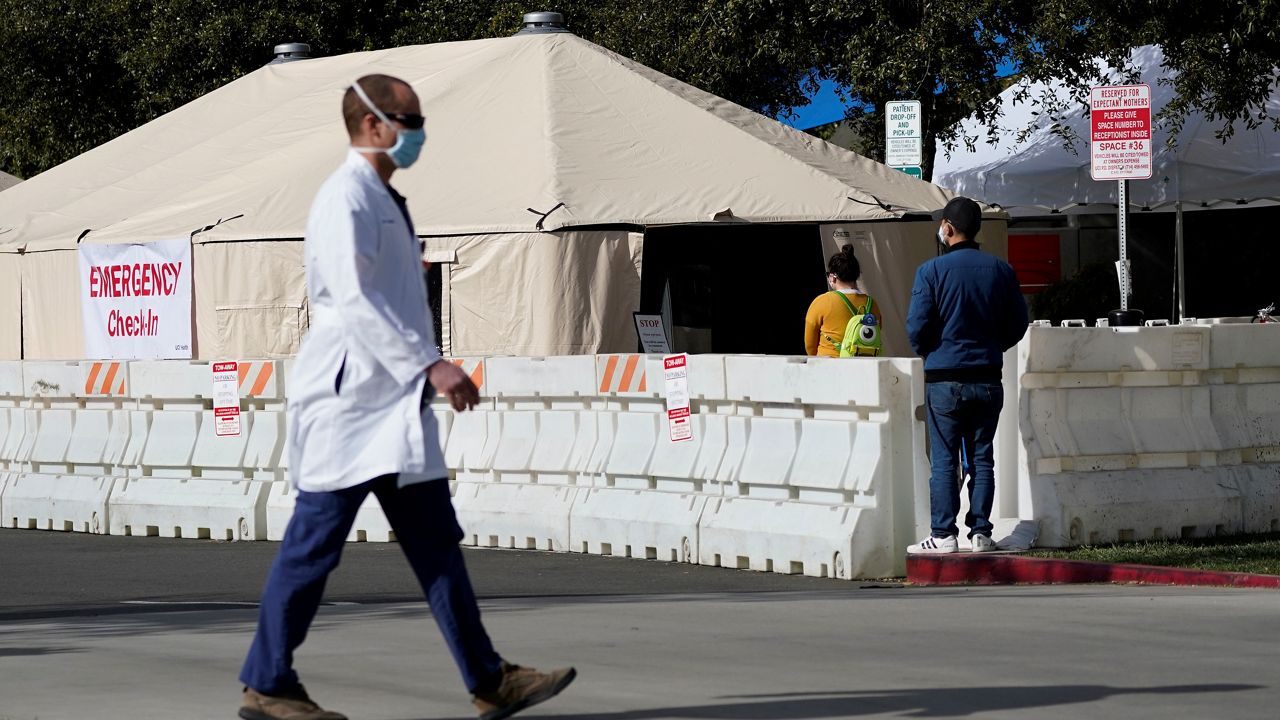SANTA ANA, Calif. (CNS) — The number of coronavirus patients in Orange County hospitals dropped slightly Sunday, declining from 184 Saturday to 181, according to the latest state figures.
The number of those patients in intensive care dropped from 46 to 43.
What You Need To Know
- The number of coronavirus patients in Orange County hospitals dropped from 184 Saturday to 181
- The number of those patients in intensive care dropped from 46 to 43
- The county had 24.4% of its ICU beds available and 68% of its ventilators
- Officials are also keeping a wary eye on the new omicron variant, which has now been detected in Canada
The county had 24.4% of its ICU beds available and 68% of its ventilators, according to the Orange County Health Care Agency.
On Wednesday, the county reported 180 new cases of COVID-19 and nine additional deaths associated with the virus, bringing its cumulative totals to 311,397 cases and 5,675 fatalities since the pandemic began.
The OCHCA did not update case and death numbers Thursday or Friday due to the Thanksgiving holiday, and does not issue updates on weekends, so the next update will come Monday.
Officials are also keeping a wary eye on the new omicron variant, which has now been detected in Canada after first cropping up in Africa and then in Europe.
Canadian health officials said Sunday that two cases of the variant were detected in Ontario.
"California is closely monitoring the new omicron variant, which has not yet arrived in California or the U.S.," state Public Health Director Tomas Aragon said Sunday. "Vaccines continue to be our best way through the pandemic by safely protecting us against severe illness from COVID-19 and its variants. We are doubling down on our vaccination and booster efforts to ensure that all Californians have access to safe, effective, and free vaccines that can prevent serious illness and death."
Orange County's deputy health officer told reporters on Wednesday that although COVID-19 infection and hospitalization rates have generally been inching down, it may be the floor before an expected winter surge.
"It's obviously plateaued," Dr. Regina Chinsio-Kwong said. "I think this may be our new floor ... I'm hoping it will continue to decline, but with all the celebrations coming up and gatherings there is potential it will increase slightly, and there's a potential for a surge in January."
That echoes what Andrew Noymer, an epidemiologist and UC Irvine professor of population health and disease prevention, told City News Service on Tuesday.
"We found a floor, and it's around 200 cases in the hospital," Noymer said. "I think it's going to be awhile before it's lower than that. I think it's going to bounce around that and sometime during the winter it will bounce back up."
He added that May or June "will be like last May and June and things will go down lower, but we will have bought and paid for that lower level with a lot of dead people over the winter."
The county's weekly COVID-19 case rate per 100,000 residents declined from 7.3 in the previous two weeks to 6.9 on Tuesday, while the rate of people testing positive for the virus ticked down from 2.8% the previous week to 2.7%.
The county's Health Equity Quartile positivity rate — which measures progress in low-income communities — inched up from 2.9% to 3%, the same as two weeks ago.
The county's case rate per 100,000 for the fully vaccinated was at 2.6 as of Nov. 20, down from 3.2 as of Nov. 13, according to the latest data available. The case rate for the unvaccinated was at 13.8, down from 16.3, during the same time period.
As of last Monday, 71% of the total population had received at least one dose of a COVID vaccine, and 64% were fully vaccinated, according to Chinsio-Kwong. For the population eligible for a vaccine, ages 5 and above, 75% have received at least one dose and 68% were fully vaccinated.
Among those 65 and older, 95% have received at least one dose and 88% are fully vaccinated.
In the newly eligible age group of 5 to 11, 13%, or 35,022 children, have received at least one dose.
"I think it's reassuring," Chinsio-Kwong said of vaccination rates. "But I think we can do a lot better, especially with the holidays around the corner. Our biggest risk is all of these small gatherings. I know people want to hug, laugh, eat and drink and usually when that happens in a closed environment people don't have a mask on people might have COVID and not have symptoms and transmit it to others and not know about it until three to seven days later."
Chinsio-Kwong advised testing for COVID-19 for those who travel or get together at parties.
The vaccination rate appears to have picked up last week as many children are out of school, Chinsio-Kwong said.
"So we did see a rise in vaccinations on Monday and then on Tuesday," she said. "It's reassuring we're above 10,000 on a daily basis. Sometimes it's upward of 19,000."



